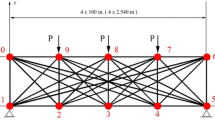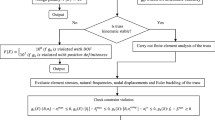Abstract
This article proposes a novel topology framework for simultaneously optimizing topology, size and shape of truss structures with multiple constraints under static, free vibration and transient responses for the first time. To achieve such a purpose, the topology pseudo-area variable of members is newly proposed discretely assigning to either \(10^{-3}\) or 1 to respectively represent the absence or presence of a member. This suggestion aims at not only evading the numerical instability due to the singularity of global stiffness matrix when solving equilibrium equations in finite element analyses but also saving the computational effort owing to the intact preserve of FE model structure. The objective function of this study is to minimize the structural weight. The cross-sectional area of truss members is taken discrete/continuous design variables into account, whilst nodal coordinates are treated as continuous ones. In addition, kinematic stability, displacement, stress, Euler buckling loading, natural frequency and transient behavior are dealt with as constraints. The derivative-free adaptive hybrid evolutionary firefly algorithm is utilized as an optimizer to resolve such optimization problems including mixed continuous-discrete variables. A large number of benchmark examples are tested to verify the validity of the presented paradigm. Obtained outcomes indicate that the present methodology is effective and robust in searching better high-quality optimal solutions against many existing algorithms in the literature.




















Similar content being viewed by others
References
Bellagamba L, Yang TY (1981) Minimum-mass truss structures with constraints on fundamental natural frequency. AIAA J 19:1452–1458
Gomes HM (2011) Truss optimization with dynamic constraints using a particle swarm algorithm. Expert Syst Appl 38:957–968
Miguel LFF, Fadel Miguel LF (2012) Shape and size optimization of truss structures considering dynamic constraints through modern metaheuristic algorithms. Expert Syst Appl 39:9458–9467
Kaveh A, Zolghadr A (2012) Truss optimization with natural frequency constraints using a hybridized CSS-BBBC algorithm with trap recognition capability. Comput Struct 102–103:14–27
Kaveh A, Ghazaan MI (2015) Hybridized optimization algorithms for design of trusses with multiple natural frequency constraints. Adv Eng Softw 79:137–147
Khatibinia M, Naseralavi SS (2014) Truss optimization on shape and sizing with frequency constraints based on orthogonal multi-gravitational search algorithm. J Sound Vib 333:6349–6369
Grandhi RV, Venkayya VB (1988) Structural optimization with frequency constraints. AIAA J 26:858–866
Banh TT, Lee D (2018) Multi-material topology optimization design for continuum structures with crack patterns. Compos Struct 186:193–209
Nguyen AP, Banh TT, Lee D, Lee J, Kang J, Shin S (2018) Design of multiphase carbon fiber reinforcement of crack existing concrete structures using topology optimization. Steel Compos Struct 29:635–645
Banh TT, Lee D (2019) Topology optimization of multi-directional variable thickness thin plate with multiple materials. Struct Multidiscip Optim 59:1503–1520
Banh TT, Nguyen XQ, Herrmann M, Filippou FC, Lee D (2020) Multiphase material topology optimization of Mindlin–Reissner plate with nonlinear variable thickness and Winkler foundation. Steel Compos Struct 35:129–145
Banh TT, Luu NG, Lee D (2021) A non-homogeneous multi-material topology optimization approach for functionally graded structures with cracks. Compos Struct 273:114230
Wu SJ, Chow PT (1995) Steady-state genetic algorithms for discrete optimization of trusses. Comput Struct 56:979–991
Li LJ, Huang ZB, Liu F (2009) A heuristic particle swarm optimization method for truss structures with discrete variables. Comput Struct 87:435–443
Sadollah A, Bahreininejad A, Eskandar H, Hamdi M (2012) Mine blast algorithm for optimization of truss structures with discrete variables. Comput Struct 102–103:49–63
Kaveh A, Mahdavi VR (2014) Colliding bodies optimization method for optimum discrete design of truss structures. Comput Struct 139:43–53
Nguyen-Van S, Nguyen KT, Luong VH, Lee S, Lieu QX (2021) A novel hybrid differential evolution and symbiotic organisms search algorithm for size and shape optimization of truss structures under multiple frequency constraints. Expert Syst Appl 184:115534
Nguyen-Van S, Nguyen KT, Dang KD, Nguyen NTT, Lee S, Lieu QX (2021) An evolutionary symbiotic organisms search for multiconstraint truss optimization under free vibration and transient behavior. Adv Eng Softw 160:103045
Deb K, Gulati S (2001) Design of truss-structures for minimum weight using genetic algorithms. Finite Elem Anal Des 37:447–465
Miguel LFF, Lopez RH, Miguel LFF (2013) Multimodal size, shape, and topology optimisation of truss structures using the Firefly algorithm. Adv Eng Softw 56:23–37
Savsani VJ, Tejani GG, Patel VK (2016) Truss topology optimization with static and dynamic constraints using modified subpopulation teaching–learning-based optimization. Eng Optim 48:1990–2006
Savsani VJ, Tejani GG, Patel VK, Savsani P (2017) Modified meta-heuristics using random mutation for truss topology optimization with static and dynamic constraints. J Comput Des Eng 4:106–130
Assimi H, Jamali A, Nariman-zadeh N (2017) Sizing and topology optimization of truss structures using genetic programming. Swarm Evol Comput 37:90–103
Assimi H, Jamali A (2018) A hybrid algorithm coupling genetic programming and Nelder–Mead for topology and size optimization of trusses with static and dynamic constraints. Expert Syst Appl 95:127–141
Xu B, Jiang J, Tong W, Wu K (2003) Topology group concept for truss topology optimization with frequency constraints. J Sound Vib 261:911–925
Kaveh A, Zolghadr A (2013) Topology optimization of trusses considering static and dynamic constraints using the CSS. Appl Soft Comput 13:2727–2734
Lee KS, Geem ZW (2004) A new structural optimization method based on the harmony search algorithm. Comput Struct 82:781–798
Li LJ, Huang ZB, Liu F, Wu QH (2007) A heuristic particle swarm optimizer for optimization of pin connected structures. Comput Struct 85:340–349
Luh GC, Lin CY (2008) Optimal design of truss structures using ant algorithm. Struct Multidiscip Optim 36:365–379
Wu CY, Tseng KY (2010) Truss structure optimization using adaptive multi-population differential evolution. Struct Multidiscip Optim 42:575–590
Fenton M, McNally C, Byrne J, Hemberg E, McDermott J, O’Neill M (2014) Automatic innovative truss design using grammatical evolution. Autom Constr 39:59–69
Kaveh A, Bakhshpoori T, Afshari E (2014) An efficient hybrid particle swarm and swallow swarm optimization algorithm. Comput Struct 143:40–59
Kaveh A, Bakhshpoori T (2016) A new metaheuristic for continuous structural optimization: water evaporation optimization. Struct Multidiscip Optim 54:23–43
Lieu QX, Do DTT, Lee J (2018) An adaptive hybrid evolutionary firefly algorithm for shape and size optimization of truss structures with frequency constraints. Comput Struct 195:99–112
Storn R, Price K (1997) Differential evolution—a simple and efficient heuristic for global optimization over continuous spaces. J Glob Optim 11:341–359
Yang XS (2010) Firefly algorithm, Lévy flights and global optimization. In: Research and development in intelligent systems XXVI. Springer, Berlin, pp 209–218
Yang XS (2010) Firefly algorithm, stochastic test functions and design optimisation. Int J BioInspir Comput 2:78–84
Yang XS (2014) Nature-inspired optimization algorithms. Elsevier Science Publishers B. V, Amsterdam
Lieu QX, Lee J (2017) Modeling and optimization of functionally graded plates under thermo-mechanical load using isogeometric analysis and adaptive hybrid evolutionary firefly algorithm. Compos Struct 179:89–106
Lieu QX, Lee J, Lee D, Lee S, Kim D, Lee J (2018) Shape and size optimization of functionally graded sandwich plates using isogeometric analysis and adaptive hybrid evolutionary firefly algorithm. Thin Walled Struct 124:588–604
Lieu QX, Lee J (2019) An isogeometric multimesh design approach for size and shape optimization of multidirectional functionally graded plates. Comput Methods Appl Mech Eng 343:407–437
Lieu QX, Lee J (2019) A reliability-based optimization approach for material and thickness composition of multidirectional functionally graded plates. Compos Part B Eng 164:599–611
Lieu QX, Luong VH, Lee J (2020) Structural damage identification using adaptive hybrid evolutionary firefly algorithm. In: Dey N (ed) Applications of firefly algorithm and its variants: case studies and new developments. Springer tracts in nature-inspired computing. Springer, Singapore, pp 75–97
Ghosh A, Mallik AK (1976) Theory of mechanisms and machines. Affiliated East-West Press, New Delhi
Reddy J (2005) An introduction to the finite element method. McGraw-Hill Education, New York
Lieu QX, Lee J (2017) Multiresolution topology optimization using isogeometric analysis. Int J Numer Methods Eng 112:2025–2047
Katsikadelis JT (2020) Chapter 12—Multi-degree-of-freedom systems: free vibrations. In: Katsikadelis JT (ed) Dynamic analysis of structures. Academic Press, Cambridge, pp 523–600
Simon D (2013) Evolutionary optimization algorithms. Wiley, New York
Padhye N, Bhardawaj P, Deb K (2013) Improving differential evolution through a unified approach. J Glob Optim 55:771–799
Rajan SD (1995) Sizing, shape, and topology design optimization of trusses using genetic algorithm. J Struct Eng 121:1480–1487
Balling RJ, Briggs RR, Gillman K (2006) Multiple optimum size/shape/topology designs for skeletal structures using a genetic algorithm. J Struct Eng 132:1158–1165
Martini K (2011) Harmony search method for multimodal size, shape, and topology optimization of structural frameworks. J Struct Eng 137:1332–1339
Wu SJ, Chow PT (1995) Integrated discrete and configuration optimization of trusses using genetic algorithms. Comput Struct 55:695–702
Tang W, Tong L, Gu Y (2005) Improved genetic algorithm for design optimization of truss structures with sizing, shape and topology variables: improved genetic algorithm for design optimization. Int J Numer Methods Eng 62:1737–1762
Acknowledgements
This research is funded by Vietnam National University Ho Chi Minh City (VNU-HCM) under Grant number C2021-20-33. We would like to thank Ho Chi Minh City University of Technology (HCMUT), VNU-HCM for the support of time and facilities for this study.
Author information
Authors and Affiliations
Contributions
QXL: conceptualization, methodology, investigation, data curation, validation, resources, software, writing-original draft, writing-review and editing, funding acquisition, project administration.
Corresponding author
Ethics declarations
Conflict of interest
The authors declare that they have no known competing financial interests or personal relationships that could have appeared to influence the work reported in this paper.
Additional information
Publisher's Note
Springer Nature remains neutral with regard to jurisdictional claims in published maps and institutional affiliations.
Rights and permissions
About this article
Cite this article
Lieu, Q.X. A novel topology framework for simultaneous topology, size and shape optimization of trusses under static, free vibration and transient behavior. Engineering with Computers 38, 1–25 (2022). https://doi.org/10.1007/s00366-022-01599-5
Received:
Accepted:
Published:
Issue Date:
DOI: https://doi.org/10.1007/s00366-022-01599-5




